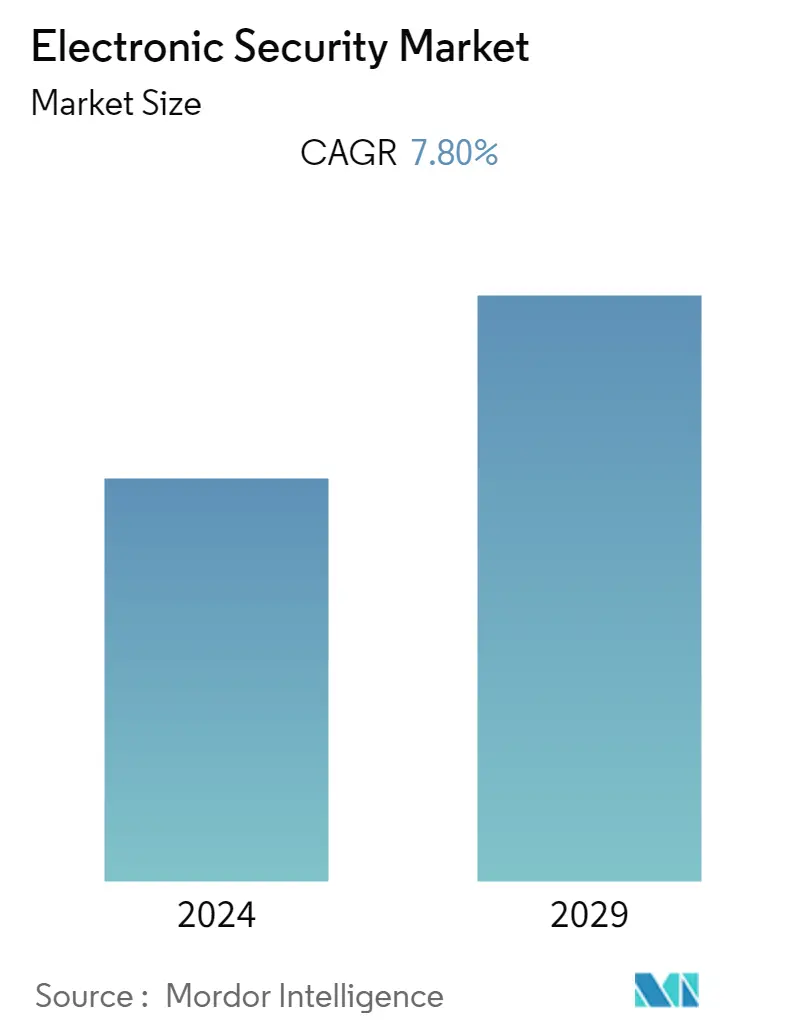Market Size of Electronic Security Industry

| Study Period | 2019 - 2029 |
| Base Year For Estimation | 2023 |
| CAGR | 7.80 % |
| Fastest Growing Market | Asia-Pacific |
| Largest Market | North America |
| Market Concentration | Low |
Major Players
*Disclaimer: Major Players sorted in no particular order |
Electronic Security Market Analysis
The Electronic Security Market size is expected to grow from USD 52.37 billion in 2023 to USD 76.24 billion by 2028, at a CAGR of 7.80% during the forecast period (2023-2028).
The COVID -19 pandemic drove electronic security creation, emphasizing pieces of technology that would be essential in maintaining broader business momentum in the immediate future. With the rise in the digitation of commercial operations due to the pandemic, the need for electronic security systems showed significant growth in India.
- IP video surveillance was primarily used for security purposes for additional reasons across regions during the COVID-19 pandemic. These high-end cameras are well equipped with high-performance computing power and video analytics, enabling the users to transform real-time images into big data analysis. Under social distancing practices and norms, several video analytic techniques were commonly deployed to take precautionary measures, including queue management, people counting, crowd detection, and personal protective equipment (PPE).
- The electronic security system performs security operations, like access control, alarm, surveillance, or intrusion control, for a facility or an area that utilizes power from mains and a power backup, like a battery, etc. It also has some operations, such as electrical and mechanical gear. The perseverance of a type of security system is purely based on the area to be protected and its threats.
- Electronic security relates to leveraging creation in defensive holding by expecting unapproved access to individuals and property. The government is a versatile and significant customer of such security administrations. Business sections also use security systems for their employees. Nowadays, one can see their usage in various domestic applications and small stores.
- Governments are investing in reducing the increasing rate of crimes globally. Implementing mass surveillance systems has helped track the suspects. A License Plate Reader (LRP) on the roads is increasing in response to unsafe driving. According to the NHTSA 2021 report, the fatality rate for 2021 was 1.33 per 100 million vehicle miles traveled. The root cause of such motor vehicle fatalities is overspeeding.
- Furthermore, healthcare workers must process, sterilize, and operate many consumable and disposable medical products under carefully controlled conditions to ensure patient safety. By developing authentication and security features in medical devices, manufacturers and healthcare centers can help assure that these limited-use medical products cannot be reused or used too often and that counterfeits can be efficiently detected and removed from the supply chain.
- Further, the ongoing digitization and the ever-increasing deployment of video surveillance systems are accelerating the market growth. The industry has witnessed growth in the recent innovations in security, surveillance, and network offerings, gradually reducing the costs of specialized products and increasing their overall effectiveness. In addition, such advancements have also minimized the cost of deployment of surveillance infrastructure within the premise.
- The market is also witnessing increased instances of investment in startup firms. For example, LDC, a mid-market private equity firm, recently announced an investment of USD 36 million in Wireless CCTV (WCCTV), a provider of re-deployable surveillance solutions.
Electronic Security Industry Segmentation
Electronic security includes implementing electronic technologies and devices to ensure the efficient physical security of government sites, and commercial and industrial spaces.
The study includes a detailed breakdown of the electronic security market segmented by Product Type (Surveillance Security System, Alarming System, Access and Control System, Other Product Types), End-user Vertical (Government, Transportation, Industrial, Banking, Hotels, Retail Stores, Other End-User Vertical), and Geography (North America, Europe, Asia-Pacific, Latin America, Middle East, and Africa). The impact of COVID-19 on the market and the affected segments are also covered under the scope of the study. Further, the disrupting factors impacting the market's growth in the near future have been covered in the study.
The market sizes and forecasts are provided in terms of value (USD) for all the above segments.
| By Product Type | |
| Surveillance Security System | |
| Alarming System | |
| Access and Control System | |
| Other Product Types |
| By End-user Vertical | |
| Government | |
| Transportation | |
| Industrial | |
| Banking | |
| Hotels | |
| Retail stores | |
| Other End-user Verticals |
| By Geography | |
| North America | |
| Europe | |
| Asia-Pacific | |
| Latin America | |
| Middle East and Africa |
Electronic Security Market Size Summary
The Electronic Security Market is poised for significant expansion, driven by the increasing need for advanced security solutions across various sectors. The market's growth trajectory has been accelerated by the COVID-19 pandemic, which underscored the importance of electronic security systems in maintaining business continuity and safety. The surge in digitization of commercial operations has further fueled the demand for these systems, particularly in regions like India. The market is characterized by the widespread adoption of IP video surveillance, which has become a crucial tool for security management, leveraging high-performance computing and video analytics to enhance real-time monitoring and data analysis. This technological evolution has made surveillance systems more accessible and affordable, especially in developing countries, thereby broadening their adoption across domestic and commercial applications.
Governments and businesses are increasingly investing in electronic security to combat rising crime rates and enhance safety measures. The implementation of mass surveillance systems, including facial recognition and license plate readers, has become a common practice to track and deter criminal activities. The healthcare sector is also witnessing a surge in the adoption of security features in medical devices to ensure patient safety and prevent counterfeit products. The market is further bolstered by the development of smart city initiatives, particularly in the Asia-Pacific region, where governments are investing heavily in surveillance and security infrastructure. The competitive landscape of the market is marked by the presence of major players who are focusing on product innovation and strategic partnerships to maintain their market position and expand their geographic reach.
Electronic Security Market Size - Table of Contents
-
1. MARKET INSIGHTS
-
1.1 Market Overview
-
1.2 Industry Value Chain Analysis
-
1.3 Industry Attractiveness - Porter's Five Forces Analysis
-
1.3.1 Threat of New Entrants
-
1.3.2 Bargaining Power of Consumers
-
1.3.3 Bargaining Power of Suppliers
-
1.3.4 Threat of Substitute Products
-
1.3.5 Intensity of Competitive Rivalry
-
-
1.4 Assessment of the Impact of COVID-19 on the Industry
-
-
2. MARKET SEGMENTATION
-
2.1 By Product Type
-
2.1.1 Surveillance Security System
-
2.1.2 Alarming System
-
2.1.3 Access and Control System
-
2.1.4 Other Product Types
-
-
2.2 By End-user Vertical
-
2.2.1 Government
-
2.2.2 Transportation
-
2.2.3 Industrial
-
2.2.4 Banking
-
2.2.5 Hotels
-
2.2.6 Retail stores
-
2.2.7 Other End-user Verticals
-
-
2.3 By Geography
-
2.3.1 North America
-
2.3.2 Europe
-
2.3.3 Asia-Pacific
-
2.3.4 Latin America
-
2.3.5 Middle East and Africa
-
-
Electronic Security Market Size FAQs
What is the current Electronic Security Market size?
The Electronic Security Market is projected to register a CAGR of 7.80% during the forecast period (2024-2029)
Who are the key players in Electronic Security Market?
Axis Communications AB, Bosch Security Systems Inc., Honeywell International Inc., Tyco Security Products and Checkpoint Systems Inc. are the major companies operating in the Electronic Security Market.

